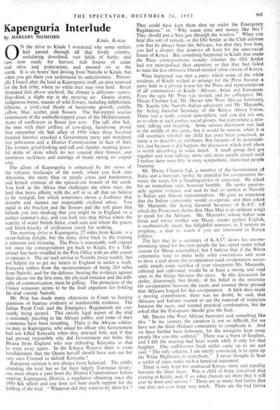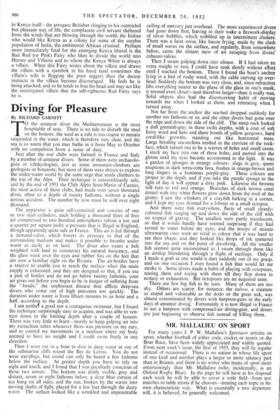Kapenguria Interlude
By MARGERY MUMFORD Kitale, Kenya.
0 N the drive to Kitale I wondered why some settlers had passed through all that lovely country, undulating downland, vast fields of barley and oats now ready for harvest, rich forests of cedar and olive and podocarpus, and pressed on to the north. It is six hours' fast driving from Nairobi to Kitale, but when you get there you understand its seductiveness. Person- ally I lusted after the land at Kapenguria itself, an area reserved for the Suk tribe, where no white man may own land. Seven thousand feet above sea-level, the climate is delicious—sunny, blue-skied, a slight nip in the morning air. Grassy slopes, indigenous forest, masses of wild flowers, including delphinium, hibiscus, a pinky-red thistle of handsome growth, purple, yellow, blue, scarlet, pink flowers. The flat-topped acacias reminiscent of the umbrella-topped pines of the Mediterranean. Acres of sunflowers in flower just now. The tall, slim Suk, the men with their coiffure of cow-dung, handsome, proud (but remember the Suk affair of 1950 when three hundred frenzied fanatics attacked a Government party and murdered two policemen and a District Commissioner in face of fire). The women, good-looking and tall and slender, wearing grace- ful skirts of skins which do not conceal their breasts, and enormous necklaces and earrings of beads strung on copper wire.
The allure of Kapenguria is enhanced by the views of the volcanic landscape of the north, where you look into Abyssinia, the misty blue or purple cones and battlements and fretted cornices of the spewed-out bowels of the earth. You look at the Africa that challenges the white man, the land that bears affinity with the self in us all that we believe to. be vestigial, but which sometimes shows a liveliness that disturbs and shames our respectable civilised selves. You stand in the bracken and the flowers and the soft grass that befools you into thinking that you might be in England on a perfect summer's day, and you look into that Africa where the scarcity of water breeds fierce, cruel men and where the graces and knick-knacks of civilisation count for nothing.
The morning drive to Kapenguria, 27 miles from Kitale, is a never-failing delight, but the dusty drive back in the evening is tiresome and irritating. The Press is reasonably well catered for, once the correspondents get back to Kitale, for a Tele- printer has been installed in the Post Office with an able expert to operate it. The air mail service to Nairobi, twice weekly. has not helped me to get my letters to England in under a week. Everyone suffers from the inconveniences of being 260 miles from Nairobi, and for the defence, hearing the evidence against their clients for the first time, the physical distance and the diffi- culty of communication, must be galling. The protection of the Crown witnesses seems to be the final argument for holding the trial outside Nairobi.
Mr. Pritt has made many objections in Court to leading questions or hearsay evidence Or inadmissible evidence. The Indian Penal Code and the Emergency Regulations are con- stantly being quoted. This strictly legal aspect of the trial is extremely puzzling to the African public, and some of their comments have been revealing. There is the African soldier, on duty at Kapenguriap.who asked his officer why Government had not killed Kenyatta when they arrested him, and if that had proved impossible why did Government not bribe this Bwana from England who was defending Kenyatta so that he went away again. In the Kikuyu Reserve there is some bewilderment that the Queen herself should have sent out her very own Counsel to defend Kenyatta !
European opinion is not always more balanced. The public attending the trial has so far been largely European (every- one must obtain a pass from the District Commissioner before entering Kapenguria District, a regulation obtaining since the 1950 Suk affair) and one does not hear much support for the holding of the trial. " Whatever did they want to try them for ? They could have kept them shut up under the Emergency Regulations," or, " Why waste time and money like this ? They should put a Sten gun through the window." When you hear this sort of remark, or the Old Settler at the Club informs you that he always beats his Africans, but that they love him, you feel a despair that destroys all hope for the inter-racial future of Kenya. But something happened in Kitale that made the Press correspondents wonder whether the Old Settler had not monopolised their attention, so that they had failed to meet the less obtrusive liberal-minded white citizen of Kenya.
What happened was that a party which soma of the white residents of Kitale wished to arrange for the Press became a party held in a private house for the Press and representatives of all communities in Kitale—African, Asian and European. Even the ogre Mr. Pritt was invited, and his colleagues, Mr. Diwan Chaman Lal. Mr. Davies (the West African barrister), Mr. Kapila (the Nairobi-Indian advocate) and Mr. Marumbi. the Acting General Secretary of the Kenya Africa Union. There was a really cordial atmosphere, and you did not see, as so often at such parties. racial groups, but everywhere a mix- ture, talking and laughing. Some serious discussion was had in the middle of this party, but it would be unwise, when it is still uncertain whether the child has even been conceived, to name it or describe its attributes. But because of its potentiali- ties, just because it did happen, the discussion which took place is worth describing in some detail. A small group first got together and were talking; more and more people joined until I reckon there were fifty or sixty sympathetic, interested people listening.
Mr. Diwan Chaman Lal, a member of the Government of India and a barrister, spoke: he appealed for co-operation be- tween the races, for a breaking-down of suspicion. He asked for an immediate start, however humble. He spoke passion- ately against violence. and said he had so spoken in Nairobi to Indian and African representatives. He gave an assurance that the Indian community would co-operate, and then asked Mr. Marumbi, the Acting General Secretary of K.A.U. (of which the Prosecutor claims that Mau Mau is its militant wing) to speak for the Africans. Mr. Marumbi, whose father was Goan and whose mother was Masai, speaks perfect English, is unobtruSively smart, has delightful manners, is, I venture to prophesy, a man to watch if you are interested in Kenya politics. The fact that he is secretary of K.A.U' shows his uncom- promising stand for his own people (he has opted under tribal custom for Masai nationality); but I believe that if the White community were to make truly solid concessions and were to show a real desire for co-operation (and co-operation neces- sarily entails some sacrifice of your viewpoint) Mr. Marumbi, cultured and cultivated, would be at least a strong and vital span in the bridge between the races. At this discussion he spoke, disarmingly but firmly, of his belief in the necessity for co-operation between the races, and assured those present that Africans longed for this co-operation. A Sikh then made a moving contribution: there was no doubt, he said, that Africans and Indians wanted to see the removal of suspicion between the races, and wanted practical combination, but to asked that the Europeans should give the lead.
Mr. Davies (the West African barrister) said something like this. " In my country the situation is not so difficult, for wo have not the third (Indian) community to complicate it. And we have further been fortunate, for the mosquito kept away people like you (the settlers)." There was a burst of laughter, and I felt the meeting had been worth while if only for that laughter. One well-known local settler came up to me and said, " The only solution, I am utterly convinced, is to open up the White Highlands to everybody." I never thought to hear a settler of years make such a heretical statement. There is only hope for interracial Kenya: unity and equality between the three races. Was a child of hope conceived that evening at Kitale, and, if so, what chances are there that it will ever be born and survive ? There are so many bad fairies that one dare not even hope very much. There are the bad fairies in Kenya itself—the arrogant Britisher clinging to his outmoded but pleasant way of life, the complacent civil servant sheltered from the winds that are blowing through the world, the Indian who would like Kenya as a colony for some of the surplus population of India, the embittered African criminal. Perhaps more immediately fatal for the emerging Kenya liberal is the Bad Red (or Pink) Fairy who likes to divide the world into Heroes and Villains and to whom the Kenya White is always a villain. When this Fairy writes about the villain and draws the villain with a sjambok in his hand (and sometimes the villain's wife is flogging the poor nigger) then the decent instincts in the villain become discouraged. He feels be is being attacked, and so he tends to lose his head and may act like the unmitigated villain that the self-righteous Red Fairy says he is.



























 Previous page
Previous page